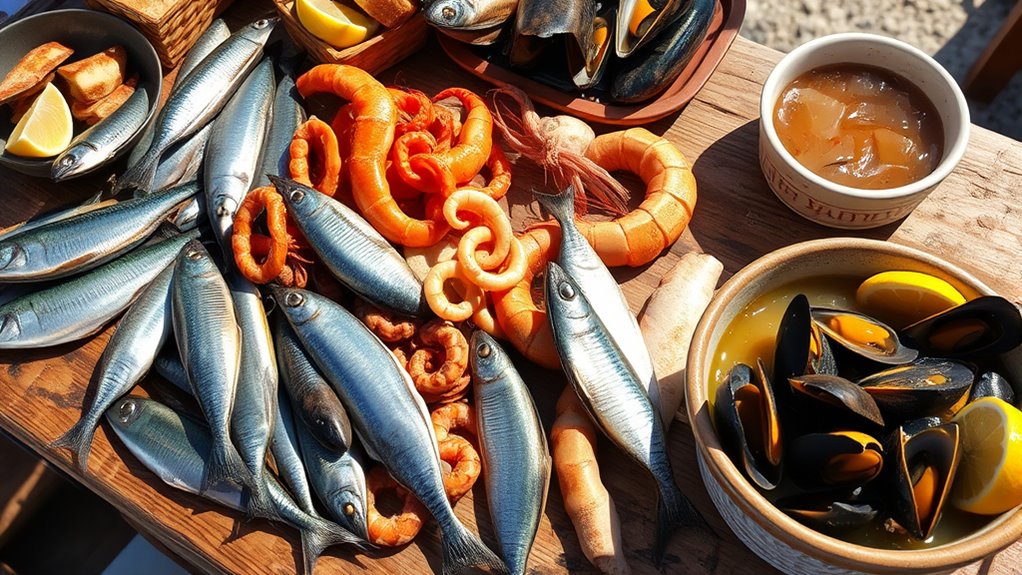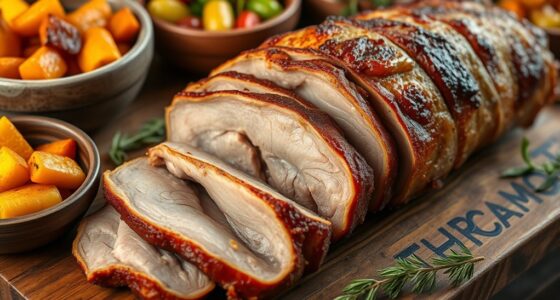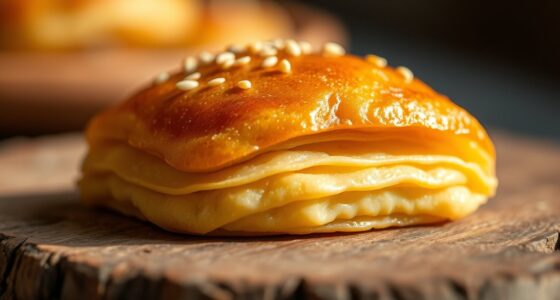In northern Sardinia, you can enjoy seafood staples like spaghetti con le vongole, featuring clams in garlic and parsley, and handcrafted Lorighittas with prawns. Fish dishes are often marinated with local olive oil, vinegar, and herbs or baked in pane carasau. The region emphasizes sustainable fishing, ensuring fresh catches like mussels, sea urchins, and bream. Discover more about these flavorful dishes and traditional seafood customs as you explore further.
Key Takeaways
- Popular dishes include Spaghetti con le vongole, featuring clams in garlic and parsley sauce, and Lorighittas ai Crostacei with prawns and scampi.
- Fregola con Arselle combines toasted Sardinian fregola with locally harvested clams cooked in flavorful broth.
- Fish preparations often involve marinating with Sardinian olive oil, vinegar, garlic, and herbs, sometimes enhanced with local wines.
- Seafood like sea urchins (ricci di mare), Cherchi (sea bream), mussels, and squid are central to regional dishes and stews.
- Coastal dining customs emphasize fresh, seasonal seafood, often served in community settings with local wine and traditional accompaniments.
Iconic Seafood Pasta Dishes of the Region
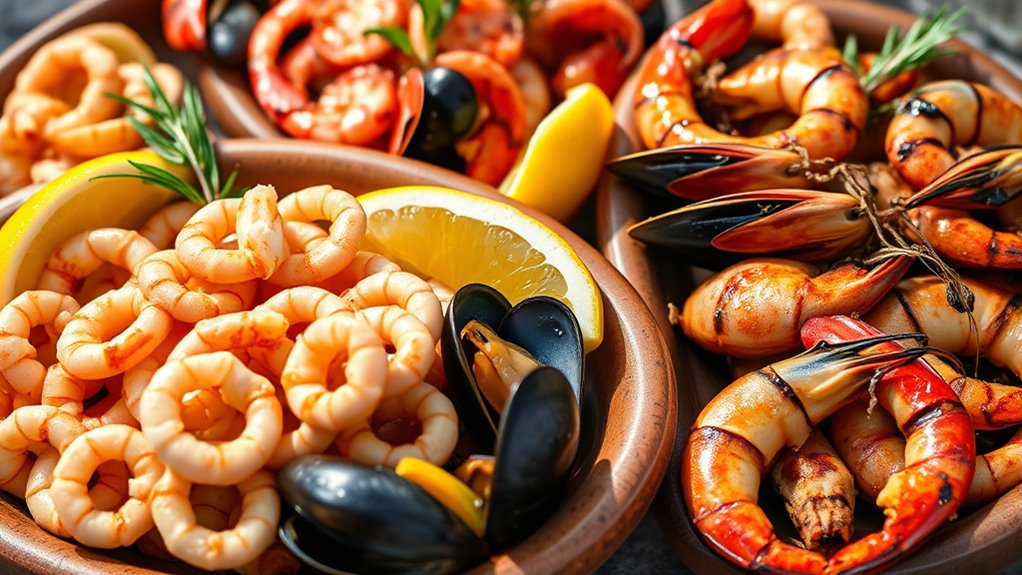
Northern Sardinia boasts a rich tradition of iconic seafood pasta dishes that showcase the region’s fresh, local ingredients. Spaghetti con le vongole is a signature dish, featuring clams steamed with garlic and bay leaf, then tossed in a garlic, parsley, bottarga, and clam cooking water sauce. Be sure to soak the clams beforehand to purge sand, and discard unopened shells for freshness. Another regional favorite is Lorighittas ai Crostacei, a handmade twisted pasta paired with prawns and scampi, highlighting fresh, minimalistic flavors. Fregola con Arselle uses toasted Sardinian fregola combined with locally harvested clams cooked in a flavorful broth, reflecting ancient culinary traditions. These dishes exemplify Sardinia’s mastery of seafood, emphasizing local ingredients and time-honored techniques. These recipes are often prepared with a focus on preserving the natural taste of the seafood, demonstrating the region’s culinary respect for its maritime bounty. Incorporating traditional cooking methods helps to enhance the authentic flavors and cultural significance of these dishes.
Traditional Fish Preparations and Marinades
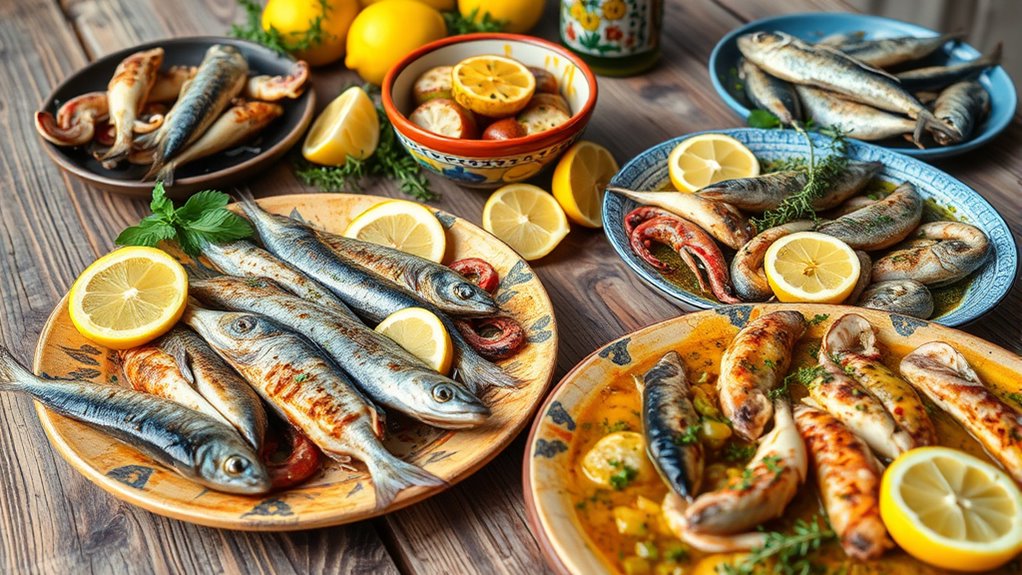
Traditional fish preparations in Northern Sardinia often revolve around flavorful marinades that enhance both taste and preservation. You’ll find common bases like rich Sardinian olive oil, vinegar, garlic, parsley, and salt, often combined to boost flavor. Some recipes incorporate local Vernaccia or white wine, adding a subtle complexity. Variations include sweet and sour profiles, with ingredients like sugar or raisins inspired by Italian soused fish traditions. Fresh herbs such as fennel, bay leaf, and mint add aromatic depth. Fish wrapped in Cherchi pane carasau before baking creates a crispy texture, complemented by caper and wine reductions. Soused fish marinated in vinegar with sautéed onions, raisins, and pine nuts offers a preserved, tangy option. These methods showcase Sardinia’s love for bold, simple flavors that highlight fresh seafood. Sardinia’s coastal location also provides a wealth of fresh, high-quality seafood that lends itself well to these traditional preparations.
Seasonal and Sustainable Seafood Harvesting Practices
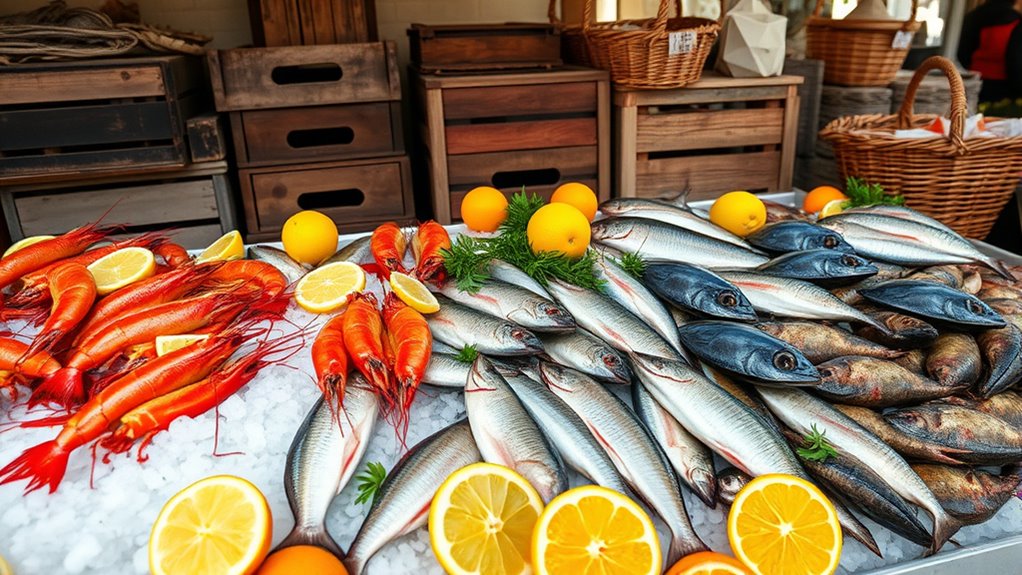
Fishing practices in Northern Sardinia emphasize sustainability by prioritizing small-scale, artisanal methods that minimize environmental impact. You’ll find over 80% of fishing boats are under 12 meters, supporting eco-friendly, local operations. The Sinis coast uses anti-trawling systems to protect marine habitats, preventing seabed damage. The Atlantic bluefin tuna, crucial to the region, is carefully managed through conservation efforts during its migration season. Concerns also surround the sea urchin fishery, prompting policy adjustments to ensure ecological and economic balance. Implementation of Anti-Trawling System further contributes to safeguarding seabeds and promoting sustainable fisheries.
Key practices include:
- Using small boats for targeted, low-impact fishing.
- Protecting marine areas with anti-trawling measures.
- Managing tuna fishing with international guidelines.
- Engaging local communities in sustainable self-regulation.
Additionally, fostering awareness of the importance of creative practice in environmental stewardship can inspire innovative ways to support sustainable fisheries.
Unique Local Seafood Ingredients and Their Uses

Sardinian cuisine features a rich array of seafood ingredients that define its distinctive flavors. You’ll find ingredients like arselle (wedge clams), prized for their delicate taste in fregola with clams, and ricci di mare (sea urchins), which add briny richness to raw or pasta dishes. Cherchi (sea bream) provides tender, mild protein, often baked in pane carasau for added texture. Mussels, littleneck clams, squid, and scallops enhance seafood stews and paellas with firm textures and subtle sweetness. These ingredients are prepared through techniques like wrapping fish in pane carasau, reducing wine with capers, and simmering clams in broth. Their unique flavors create a vibrant, authentic Sardinian seafood experience. Understanding the cooking techniques involved can help you appreciate the depth of flavors in these dishes.
Regional Culinary Customs and Dining Traditions
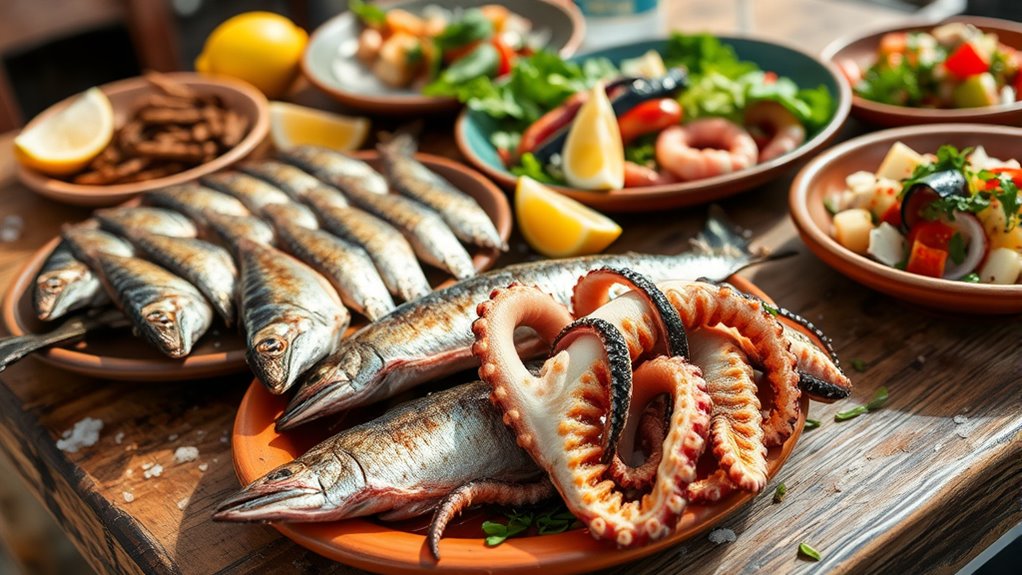
Coastal Sardinian dining customs reflect a deep connection to the island’s divided geography, where meals often alternate between land-based and sea-based fare. You’ll notice that meals typically start with mixed antipasti, like cured meats, pecorino, artichokes, or seafood such as clams in tomato broth. Here’s what shapes their traditions:
- Meals vary between seafood-only or land-based dishes, rarely mixing both.
- Lunch aboard boats or picnics on the beach highlight local bread, wine, and seafood.
- Family Sunday lunches last hours, featuring multiple courses and homemade digestifs.
- Sharing large, communal platters and drinking local wines like Vermentino deepen social bonds.
- The geographic divides influence the availability of ingredients, leading to a distinct separation between land and sea-based dishes.
These customs emphasize freshness, seasonality, and a strong sense of community, shaping Sardinia’s unique culinary identity.
Perfect Pairings and Accompaniments for Sardinian Seafood
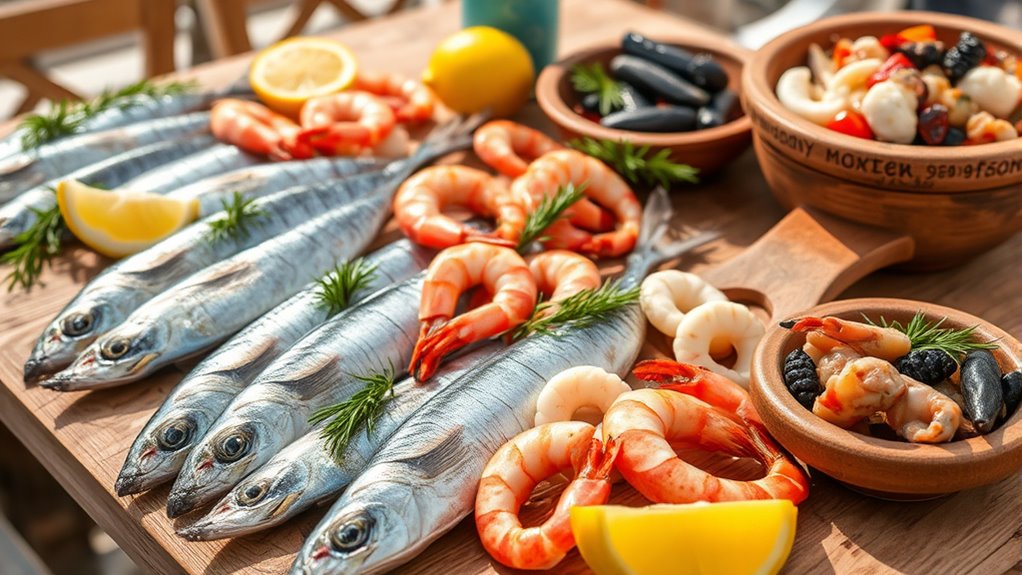
Pairing the right wine with seafood can elevate your Sardinian dining experience, highlighting the island’s rich flavors and fresh ingredients. Vermentino pairs beautifully with grilled prawns, calamari, and saffron-infused seafood risotto, adding a crisp, citrusy note. Nuragus complements seafood linguine with its floral and green apple hints, balancing richness. For spaghetti with sea urchin, a hearty Cannonau enhances the dish’s depth and robustness. Gavi offers an invigorating contrast when served with Fregola ai Frutti di Mare, emphasizing the seafood’s delicate taste. Sardinian wines provide a versatile range of pairings, enhancing textures and flavors across various seafood dishes. To truly enjoy, consider regional specialties like bottarga or seafood paella, and select wines that match the dish’s flavor profile for a memorable meal.
Frequently Asked Questions
What Are the Best Local Spots to Sample Sardinian Seafood Dishes?
You’re looking for the best spots to enjoy Sardinian seafood, and Northern Sardinia has plenty to offer. You should visit Da Giovannino for fresh fish and homemade pasta, or Trattoria Sperrittu for charming atmospheres and seafood platters. Ristorante Il Mare in Alghero and La Maddalena’s Ristorante Il Portolano are also fantastic choices. Remember to make reservations, especially at popular places, to guarantee an unforgettable seafood experience.
How Can I Identify Authentic Sardinian Seafood Preparations?
Like a treasure map, identifying authentic Sardinian seafood preparations involves knowing the key ingredients and methods. Look for fresh local fish like tuna or mullet, and watch for dishes featuring bottarga, which is like Sardinia’s caviar. Pay attention to traditional pasta shapes like fregola, seasoned with herbs like myrtle or saffron, and prepared through grilling, stewing, or baking—these clues reveal genuine Sardinian culinary craftsmanship.
Are There Any Festivals Celebrating Sardinian Seafood Cuisine?
You’ll find several festivals celebrating Sardinian seafood cuisine. During the Girotonno Tuna Festival in Carloforte, you experience live cooking and tuna traditions. The Alghero Sea Urchin Festival highlights sea urchin dishes in winter, while the Mullet Festival in Cabras focuses on mullet fish. These events showcase local fishing heritage, offering tastings and cultural activities that let you immerse yourself in Sardinia’s rich seafood culinary traditions.
What Are Common Misconceptions About Sardinian Seafood Dishes?
You might think Sardinian seafood is the mainstay of their diet, but it’s more of a “flash in the pan”—meat and cheese actually take center stage, especially inland. Many believe Italians never pair cheese with seafood, but that’s not entirely true outside local customs. Also, seafood is safer and available year-round thanks to modern regulation, debunking the myth of limited seasonality. Sardinian dishes aren’t as exotic as they seem—just deeply rooted in tradition.
How Do Seasonal Changes Affect Seafood Availability in Northern Sardinia?
Seasonal changes directly impact seafood availability in northern Sardinia. You’ll notice more pelagic fish like tuna and swordfish in summer, while shellfish such as clams and mussels are abundant in autumn and winter. Water temperature shifts influence migratory patterns, affecting what’s accessible. Fishers and restaurants adapt menus accordingly, focusing on fresh, seasonal catches, and regulations help sustain fish populations throughout the year.
Conclusion
Exploring northern Sardinia’s seafood dishes, you’ll discover a vibrant mix of fresh, sustainable ingredients and time-honored traditions. Imagine savoring a plate of fregola with clams or enjoying marinated anchovies, all paired with local wines. Even if you’re unsure about trying unfamiliar seafood, picture bursting flavors and authentic regional customs that make every bite memorable. Embrace the culinary richness—you’ll find that Sardinian seafood offers both delicious taste and a genuine cultural experience.
